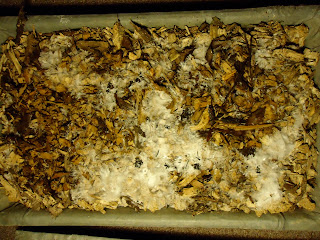 |
| Sulfur Shelf/Chicken of the Woods |
When I start talking about mushrooms I'm often confused about whether I found them or they found me. Or at least now that we've found each other, why mycelium won't seem to stop following me around, always begging for my attention.
One of my favorite things about mushrooms is the surprises they give you - the flushes of fresh shiitake I find on logs after a rain, or the discovery of a wild mushroom that reveals itself suddenly from the base of a tree. I was recently surprised by the quiet ferociousness of some King Stropharia (Stropharia rugosa-annulata) spawn that I recently inoculated in trays of soil and woodchips during a class with the Rochester Permaculture Institute.
 |
| Stropharia occupying woodchips. |
It's not just that mushrooms look cool and taste great. Its not only that they are some of the most nutritious foods we can eat. It's not the fact that they are pretty easy to cultivate. Its not even the potential to use mushrooms to help clean up toxins in the environment. It's the combination of an organism that thrives on eating dead organic matter, on breaking down carbon and building up soil, all while giving us dinner that gets me.
Cultivating shiitake logs has been the first time in my life where all the pieces have come together (at least in my pursuit of ecosystem design). Here I take oak, maple, and beech logs that are the surplus of managing a healthy forest. I inoculate them and stick them in a shady corner, waiting for the mycelium to colonize the wood. Over the next 4 years the mushroom breaks down the log and produces pounds of food. After the log is spent it returns to the forest to feed millions of organisms as they reclaim the log back into the soil.
My reward for stewarding this cycle is food, enjoyment, and part of my living. I've been working on this relationship for 5 years, and I feel like we are finally getting to understand each other.
 |
| The entire tray almost colonized after one week! |
